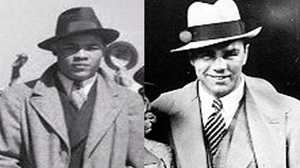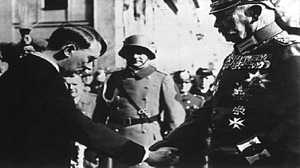Boxing the Color Line

In 1908, when Jack Johnson fought Tommy Burns to become the first African American heavyweight champion of the world, a search began for a "Great White Hope" to take back the title. American novelist Jack London wrote a newspaper column that summed up his position — and that of many Americans:
"[I] was with [Tommy] Burns all the way. He was a white man and so am I. Naturally I wanted to see the white man win. Put the case to Johnson and ask him if he were the spectator at a fight between a white man and a black man which he would like to see win. Johnson's black skin will dictate a desire parallel to the one dictated by my white skin." — The New York Herald, December 27, 1908
Competing Races
Ever since the ancient Olympic Games, athletes have represented their native or adopted nations in competition. The idea of "race" — perceived or imposed differences in appearance and culture as a means of division and domination -- came about when the age of exploration brought different people together. It wasn't until the 20th century that nations with large immigrant populations, like Australia and the United States, held sports competitions that pitted members of one "race" against another. When African American Jack Johnson took the heavyweight title from the Irish boxer Tommy Burns, the race issue in sports reached a new level. Some people did not believe that African Americans had what it took to become heavyweight champions in the "manly art" of boxing.
Fear of Black Superiority
Whether due to his enormous talent in the ring or his ostentatious personality, Jack Johnson frightened many white Americans. To them, he not only represented the awful possibility of black superiority, but he refused to "keep his place." He was not intimidated by white people, and he openly consorted with white women. Historian Jeffrey Sammons says, "Jack Johnson had to be the bravest man in America. I'm amazed at what he did publicly that many would not dare to do privately. In fact even looking at a white woman could be a death sentence at the time." (And it remained dangerous half a century later, as Emmett Tilll would discover in 1955.)
Breaking Boxing's Color Line
The fear of a powerful, uncontrollable black man remained on the minds of many when Joe Louis emerged as the next potential black champion. Neither boxer was expressly political. Johnson pushed the envelope of expectations, while Louis, although no champion of the status quo, looked moderate in comparison. But there is no doubt that these first black heavyweight champions broke through the color lines in American sports.
National Pride Trumps Racism
Though race relations were fragile in the U.S., foreign threats could cause Americans to unite in support of black Americans. The best example of this came in 1936, when Adolf Hitler expected the Berlin Olympics to showcase the superiority of the Aryan race. He left the stadium when African American track star Jesse Owens received four gold medals. Although Americans had opposed a proposed boycott of the Games, many perceived Hitler's disrespect not as white against black, but nationally -- Germany against the United States.
Being a "Good Negro"
Louis had to win over white America through how he carried himself and how he performed. His managers set down rules for their young fighter, which they shared freely with reporters. Louis' public face would be the opposite of what Johnson's had been. Historian Jeffrey Sammons lists a few of Louis' "good Negro" rules: "He could not gloat over opponents. He could not be seen in public with white women. He had to be seen as a Bible-reading, mother-loving, God-fearing individual, and not to be 'too black.'"
Thirties Racism
Despite Louis' public image campaign, millions of whites rooted against him, and awaited the "Great White Hope" who would claim boxing honors for their own race. Writer Jack Newfield says, "America was a different country... if you go back and read the sports writing of the Thirties, [you'll find] despicable, repugnant stereotypes of Louis as dumb, as lazy, on one hand, or as an animal of the jungle on the other hand." "Here was a truly savage person," Paul Gallico wrote of Louis in the New York Daily News. "I had the feeling that I was in the room with a wild animal."
Winning Respect Through His Fights
Ultimately, though, what won Louis white America's acceptance was not his mild personality and good behavior, but his dramatic matchups with German champion Max Schmeling who, to many, represented the Nazi Party. Louis would become the symbol of American freedom over Nazi totalitarianism. Many whites still wished to see Louis defeated by a white boxer, but in 1938, when Louis knocked out the German, the celebration wasn't confined to black America alone. For the first time, blacks and whites, even in the deep South, had rooted with all their hearts for the same guy. Writer Vernon Jarrett recalled, "Right after Joe Louis' victory, we got to work ahead of time. And I will say this for this fellow where I worked. He says, 'Well, it looks like your man won.' I said, 'He sure did, didn't he.' He says: 'Maybe that'll teach Hitler a lesson.'"
American Icon
Louis, like Owens, became an American icon. His status allowed him to contribute to the integration of other sports. For example, while serving in the Army, Louis met an excellent black athlete. Having raised thousands of dollars for the military by fighting exhibition matches, Louis carried some clout. "Don't you know you've got one of the outstanding football players in the country in this camp, and he can't play on the team?" he asked the Brigadier General. The officer allowed "qualified Negroes" to join the team, but Louis' friend held out: "I'm not playing football unless they let me play baseball, too." Finally, Jackie Robinson was allowed to play both sports --and became a star player at Fort Riley.
Breaking Baseball's Color Line
Years later, Branch Rickey hired Robinson to play for the Dodgers and asked Louis, Paul Robeson and other black Americans to give Robinson some idea of what to expect when he joined the major leagues. "We didn't need to say anything to Jackie. He'd been in the Army, he knew just what to look for. He knew he'd have to be strong... or he'd close the door for black people in baseball for Lord knows how many more years," Louis recalled.
Breaking Golfing's Color Line
In 1951, Louis showed up with friends to play the San Diego Open. Golfing's professional association, the PGA, held up the tournament, but finally caved and allowed black golfers to compete. Like athletes in myriad sports, Tiger Woods indirectly owes his success to Joe Louis.







